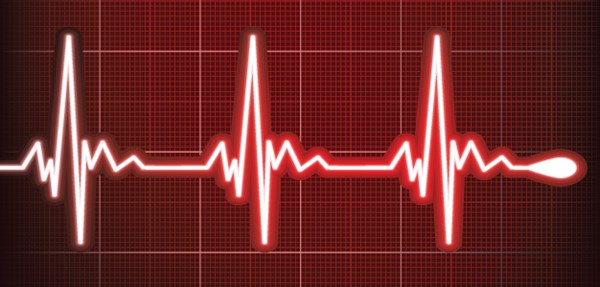Case. A 79-year-old male with a medical history of “some heart problems” presents to the emergency department with 3 days of fatigue and shortness of breath. This ECG is obtained in triage.
In reviewing this ECG, you can see the rate is normal, the QRS complex is narrow, and there are prominent repeating p-waves creating a sawtooth pattern in multiple leads. This is most consistent with atrial flutter.
Atrial flutter is a supraventricular tachycardia in which there is a reentry circuit within the right atrium. The anatomy is such that atrial flutter generally produces an atrial rate of 300 beats per minute. The ventricular rate, however, is determined by the AV node, which generally suppresses the rapid atrial rate at a ratio of 2:1, 3:1 or 4:1, thereby generating a ventricular rate of 150, 100, or 75 beats per minute respectively.
This ECG demonstrates a calculated rate of 73 beats per minute, which reflects a 4:1 AV nodal blocking ratio. As there are multiple p-waves, a PR interval cannot be calculated. In the presence of a 1:1 ratio (and a ventricular rate of approximately 300), you should expect to see significant changes in hemodynamics and prominent symptoms. Though the term AV block is commonly used, a well-functioning AV node shouldsuppress an atrial rate of 300; therefore, the AV block is normal in this case. AV nodal blocking agents can further suppress the rapid atrial rate and are often the cause of a 4:1 or greater AV block, as was the case with this patient. The flutter waves can usually be seen best in leads II, III, and aVF, and are defined as inverted in these leads. The p-waves in V1 are defined as positive and may look like normal p waves. The opposite pattern can also rarely be seen. Though a specific unchanging blocking ratio often exists, it is important to remember that a variable block can occur. In these instances, there should still be an alternating pattern of 2:1, 3:1 and 4:1 block.
Learning Points
- Atrial flutter is a supraventricular tachycardia resulting from a re-entry circuit within the right atrium.
- The atrial rate is generally 300 (though can vary between 200-400) and conduction through the AV node is blocked
at a predictable ratio of 2:1, 3:1 or 4:1, producing heart rates of 150, 100, and 75. - The most common finding of atrial flutter is the sawtooth pattern of the p-waves seen best in leads II, III, and aVF.



